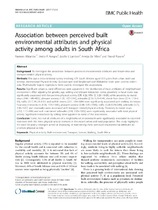| dc.contributor.author | Malambo, Pasmore | |
| dc.contributor.author | Kengne, Andre P. | |
| dc.contributor.author | Lambert, Estelle V. | |
| dc.contributor.author | De Villiers, Anniza | |
| dc.contributor.author | Puoane, Thandi | |
| dc.date.accessioned | 2017-03-10T08:01:24Z | |
| dc.date.available | 2017-03-10T08:01:24Z | |
| dc.date.issued | 2017 | |
| dc.identifier.citation | Malambo, P. et al. (2017). Association between perceived built environmental attributes and physical activity among adults in South Africa. BMC Public Health, 17(1): Art. #213 | en_US |
| dc.identifier.issn | 1471-2458 | |
| dc.identifier.uri | http://hdl.handle.net/10566/2617 | |
| dc.identifier.uri | http://dx.doi.org/10.1186/s12889-017-4128-8 | |
| dc.description.abstract | Background: To investigate the association between perceived environmental attributes and leisure-time and transport-related physical activity. Methods: This was a cross-sectional survey involving 671 South Africans aged ?35 years from urban and rural settings. International Physical Activity Questionnaire and Neighbourhood Walkability Scale were used to collect data. Multivariable logistic regressions were used to investigate the associations. Results: Significant urban vs. rural differences were apparent in the distribution of most attributes of neighborhood environment. After adjusting for gender, age, setting and relevant interaction terms, proximity to local stores was significantly associated with leisure-time physical activity (OR: 4.26; 95% CI, 1.00-18.08); while proximity to transit stops (2.44; 1.48-4.02), pleasant scenery (1.93; 1.07-3.46), sidewalks (2.36; 1.25-4.44), shade from trees (2.14; 1.19-3.85), traffic (2.17; 91.21-3.91) and well-lit streets (2.01; 1.04-3.89) were significantly associated with walking for leisure. Four-way intersections (4.54; 1.54-13.43), pleasant scenery (3.84; 1.35-10.99), traffic (0.28; 0.09-0.89), sidewalks (3.75; 1.06-13.27) and crosswalks were associated with transport related physical activity. Proximity to transit stops (2.12; 1.17-3.84) and well maintained sidewalks (2.69; 2.20-10.02) were significantly associated with total physical activity. Significant interactions by setting were apparent in some of the associations. Conclusion: Some, but not all attributes of a neighborhood environment were significantly associated in expected directions with the three physical activity domains in this mixed urban and rural population. This study highlights the need for policy strategies aimed at improving or maintaining these perceived environmental attributes to promote physical activity. | en_US |
| dc.language.iso | en | en_US |
| dc.publisher | BioMed Central Ltd. | en_US |
| dc.rights | © The Author(s). 2017 Open Access This article is distributed under the terms of the Creative Commons Attribution 4.0
International License (http://creativecommons.org/licenses/by/4.0/), which permits unrestricted use, distribution, and
reproduction in any medium, provided you give appropriate credit to the original author(s) and the source, provide a link to
the Creative Commons license, and indicate if changes were made. The Creative Commons Public Domain Dedication waiver
(http://creativecommons.org/publicdomain/zero/1.0/) applies to the data made available in this article, unless otherwise stated. | |
| dc.subject | Gender | en_US |
| dc.subject | International physical activity questionnaire | en_US |
| dc.subject | Logistic regression analysis | en_US |
| dc.subject | Rural population | en_US |
| dc.subject | South Africa | en_US |
| dc.title | Association between perceived built environmental attributes and physical activity among adults in South Africa | en_US |
| dc.type | Article | en_US |
| dc.privacy.showsubmitter | FALSE | |
| dc.status.ispeerreviewed | TRUE | |
| dc.description.accreditation | ISI | en_US |

